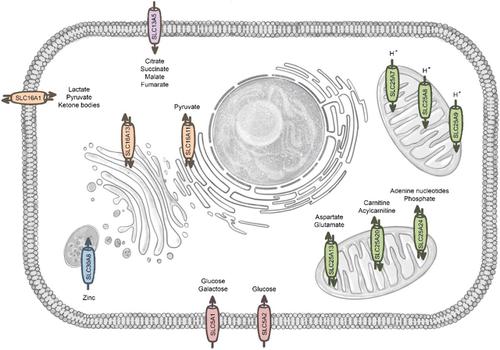当前位置:
X-MOL 学术
›
Pharmacol. Rev.
›
论文详情
Our official English website, www.x-mol.net, welcomes your feedback! (Note: you will need to create a separate account there.)
Solute Carrier Transporters as Potential Targets for the Treatment of Metabolic Disease.
Pharmacological Reviews ( IF 21.1 ) Pub Date : 2020-01-01 , DOI: 10.1124/pr.118.015735 Tina Schumann 1 , Jörg König 1 , Christine Henke 1 , Diana M Willmes 1 , Stefan R Bornstein 1 , Jens Jordan 1 , Martin F Fromm 1 , Andreas L Birkenfeld 2
Pharmacological Reviews ( IF 21.1 ) Pub Date : 2020-01-01 , DOI: 10.1124/pr.118.015735 Tina Schumann 1 , Jörg König 1 , Christine Henke 1 , Diana M Willmes 1 , Stefan R Bornstein 1 , Jens Jordan 1 , Martin F Fromm 1 , Andreas L Birkenfeld 2
Affiliation

|
The solute carrier (SLC) superfamily comprises more than 400 transport proteins mediating the influx and efflux of substances such as ions, nucleotides, and sugars across biological membranes. Over 80 SLC transporters have been linked to human diseases, including obesity and type 2 diabetes (T2D). This observation highlights the importance of SLCs for human (patho)physiology. Yet, only a small number of SLC proteins are validated drug targets. The most recent drug class approved for the treatment of T2D targets sodium-glucose cotransporter 2, product of the SLC5A2 gene. There is great interest in identifying other SLC transporters as potential targets for the treatment of metabolic diseases. Finding better treatments will prove essential in future years, given the enormous personal and socioeconomic burden posed by more than 500 million patients with T2D by 2040 worldwide. In this review, we summarize the evidence for SLC transporters as target structures in metabolic disease. To this end, we identified SLC13A5/sodium-coupled citrate transporter, and recent proof-of-concept studies confirm its therapeutic potential in T2D and nonalcoholic fatty liver disease. Further SLC transporters were linked in multiple genome-wide association studies to T2D or related metabolic disorders. In addition to presenting better-characterized potential therapeutic targets, we discuss the likely unnoticed link between other SLC transporters and metabolic disease. Recognition of their potential may promote research on these proteins for future medical management of human metabolic diseases such as obesity, fatty liver disease, and T2D. SIGNIFICANCE STATEMENT: Given the fact that the prevalence of human metabolic diseases such as obesity and type 2 diabetes has dramatically risen, pharmacological intervention will be a key future approach to managing their burden and reducing mortality. In this review, we present the evidence for solute carrier (SLC) genes associated with human metabolic diseases and discuss the potential of SLC transporters as therapeutic target structures.
中文翻译:

溶质载体转运蛋白作为代谢性疾病治疗的潜在靶标。
溶质载体(SLC)超家族包含400多种转运蛋白,介导诸如离子,核苷酸和糖等物质跨生物膜的流入和流出。超过80种SLC转运蛋白与人类疾病有关,包括肥胖症和2型糖尿病(T2D)。该观察结果凸显了SLC对人类(病理)生理学的重要性。但是,只有少量的SLC蛋白是经过验证的药物靶标。批准用于治疗T2D的最新药物类别是SLC5A2基因的产物钠-葡萄糖共转运蛋白2。将其他SLC转运蛋白识别为治疗代谢性疾病的潜在靶标引起了极大的兴趣。寻找更好的治疗方法在未来几年将变得至关重要,到2040年,全球将有超过5亿T2D患者承担巨大的个人和社会经济负担。在这篇综述中,我们总结了SLC转运蛋白作为代谢性疾病中靶标结构的证据。为此,我们鉴定了SLC13A5 /钠耦合柠檬酸盐转运蛋白,最近的概念验证研究证实了其在T2D和非酒精性脂肪肝疾病中的治疗潜力。在多个全基因组关联研究中,进一步的SLC转运蛋白与T2D或相关的代谢异常相关。除了提出更好地表征的潜在治疗目标外,我们还讨论了其他SLC转运蛋白与代谢性疾病之间可能未引起注意的联系。认识到它们的潜力可能会促进对这些蛋白质的研究,以用于未来对人类代谢性疾病(例如肥胖症,脂肪肝疾病和T2D。重要声明:鉴于肥胖和2型糖尿病等人类代谢疾病的患病率急剧上升,因此,药理干预将成为控制其负担和降低死亡率的未来关键方法。在这篇综述中,我们提供了与人类代谢性疾病相关的溶质载体(SLC)基因的证据,并讨论了SLC转运蛋白作为治疗靶标结构的潜力。
更新日期:2019-12-29
中文翻译:

溶质载体转运蛋白作为代谢性疾病治疗的潜在靶标。
溶质载体(SLC)超家族包含400多种转运蛋白,介导诸如离子,核苷酸和糖等物质跨生物膜的流入和流出。超过80种SLC转运蛋白与人类疾病有关,包括肥胖症和2型糖尿病(T2D)。该观察结果凸显了SLC对人类(病理)生理学的重要性。但是,只有少量的SLC蛋白是经过验证的药物靶标。批准用于治疗T2D的最新药物类别是SLC5A2基因的产物钠-葡萄糖共转运蛋白2。将其他SLC转运蛋白识别为治疗代谢性疾病的潜在靶标引起了极大的兴趣。寻找更好的治疗方法在未来几年将变得至关重要,到2040年,全球将有超过5亿T2D患者承担巨大的个人和社会经济负担。在这篇综述中,我们总结了SLC转运蛋白作为代谢性疾病中靶标结构的证据。为此,我们鉴定了SLC13A5 /钠耦合柠檬酸盐转运蛋白,最近的概念验证研究证实了其在T2D和非酒精性脂肪肝疾病中的治疗潜力。在多个全基因组关联研究中,进一步的SLC转运蛋白与T2D或相关的代谢异常相关。除了提出更好地表征的潜在治疗目标外,我们还讨论了其他SLC转运蛋白与代谢性疾病之间可能未引起注意的联系。认识到它们的潜力可能会促进对这些蛋白质的研究,以用于未来对人类代谢性疾病(例如肥胖症,脂肪肝疾病和T2D。重要声明:鉴于肥胖和2型糖尿病等人类代谢疾病的患病率急剧上升,因此,药理干预将成为控制其负担和降低死亡率的未来关键方法。在这篇综述中,我们提供了与人类代谢性疾病相关的溶质载体(SLC)基因的证据,并讨论了SLC转运蛋白作为治疗靶标结构的潜力。


























 京公网安备 11010802027423号
京公网安备 11010802027423号